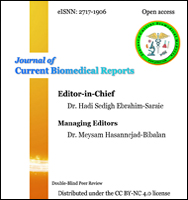Prevalence and antibiotic resistance of uropathogens in children with urinary tract infections referring to Abuzar hospital in Ahvaz
Abstract
Urinary tract infection (UTI) is a prevalent disease among children. This study is an attempt to find the bacterial agents of UTI and antibiotic resistance in children. A descriptive cross-sectional study was carried out on 1316 clinical samples of children at Abuzar Hospital in Ahvaz that had positive urine culture. The strains were determined through biochemical tests and differential culture media. The pattern of antibiotic resistance of the studied strains was determined by the disk diffusion method. Out of the 1316 children surveyed, 821 were girls and 495 were boys. The most isolated strains from urine cultures were Escherichia coli (57.52%) followed by Enterococcus (12.15%). E. coli isolates demonstrated the highest resistance to ampicillin (57.06%) and amikacin was recognized as the most effective antibiotic with a sensitivity of 91.94%. E. coli was the most common causative agent of UTI in children. Amikacin was recognized as the appropriate choice against urinary tract pathogens. Because, in different regions and over time, the frequency distribution of antibiotic resistance varies, it is recommended to carry out periodic monitoring of antibiotic resistance for infection control.
Keywords
References
Nugent J, Childers M, Singh-Miller N, Howard R, Allard R, Eberly M. Risk of Meningitis in Infants Aged 29 to 90 Days with Urinary Tract Infection: A Systematic Review and Meta-Analysis. J Pediatr. 2019; 212:102-10.e5.
Flores-Mireles AL, Walker JN, Caparon M, Hultgren SJ. Urinary tract infections: epidemiology, mechanisms of infection and treatment options. Nat Rev Microbiol. 2015; 13(5):269-84.
Bitsori M, Galanakis E. Pediatric urinary tract infections: diagnosis and treatment. Expert Rev Anti Infect Ther. 2012; 10(10):1153-64.
Mahmoudi H, Emadmomtaz H, Karimitabar Z, Emam AH, Alikhani MY. Prevalence of asymptomatic urinary tract infection in primary school children of Hamadan City and drug resistance of isolated microorganisms in 2014. Pajouhan Sci J. 2015; 13(3):8-14.
Kapur S, Bourke T, Maney JA, Moriarty P. Emergency department attendance following 4-component meningococcal B vaccination in infants. Arch Dis Child. 2017; 102(10):899-902.
Wagenlehner FME, Cloutier DJ, Komirenko AS, Cebrik DS, Krause KM, Keepers TR, et al. Once-Daily Plazomicin for Complicated Urinary Tract Infections. N Engl J Med. 2019; 380(8):729-40.
Dospinescu VM, Tiele A, Covington JA. Sniffing Out Urinary Tract Infection-Diagnosis Based on Volatile Organic Compounds and Smell Profile. Biosensors (Basel). 2020; 10(8).
Shrestha LB, Baral R, Poudel P, Khanal B. Clinical, etiological and antimicrobial susceptibility profile of pediatric urinary tract infections in a tertiary care hospital of Nepal. BMC Pediatr. 2019; 19(1):36.
Terlizzi ME, Gribaudo G, Maffei ME. UroPathogenic Escherichia coli (UPEC) Infections: Virulence Factors, Bladder Responses, Antibiotic, and Non-antibiotic Antimicrobial Strategies. Front Microbiol. 2017; 8:1566.
Kapur S, Gehani M, Kammili N, Bhardwaj P, Nag V, Devara SM, et al. Clinical Validation of Innovative Optical-Sensor-Based, Low-Cost, Rapid Diagnostic Test to Reduce Antimicrobial Resistance. J Clin Med. 2019; 8(12):2098.
Cassini A, Högberg LD, Plachouras D, Quattrocchi A, Hoxha A, Simonsen GS, et al. Attributable deaths and disability-adjusted life-years caused by infections with antibiotic-resistant bacteria in the EU and the European Economic Area in 2015: a population-level modelling analysis. Lancet Infect Dis. 2019; 19(1):56-66.
Zomorrodi A, Zargar M, Noroozi J. Evaluation of antibiotic resistance associated with ophthalmic oqxAB pumps in Klebsiella pneumoniae causing urinary tract infection. Med Sci J. 2019; 29(2):163-70.
Pape L, Gunzer F, Ziesing S, Pape A, Offner G, Ehrich JH. [Bacterial pathogens, resistance patterns and treatment options in community acquired pediatric urinary tract infection]. Klin Padiatr. 2004; 216(2):83-6.
CLSI (Ed.). Performance Standards for Antimicrobial Susceptibility Testing; 30th ed. CLSI Supplement M100. Clinical and Laboratory Standards Institute, Wayne, PA. 2020.
Saleem Z, Hassali MA, Godman B, Hashmi FK, Saleem F. A multicenter point prevalence survey of healthcare-associated infections in Pakistan: Findings and implications. Am J Infect Control. 2019; 47(4):421-4.
Izadi N, Eshrati B, Etemad K, Mehrabi Y, Hashemi-Nazari SS. Rate of the incidence of hospital-acquired infections in Iran based on the data of the national nosocomial infections surveillance. New Microbes New Infect. 2020; 38:100768.
Demir M, Kazanasmaz H. Uropathogens and antibiotic resistance in the community and hospital-induced urinary tract infected children. J Glob Antimicrob Resist. 2020; 20:68-73.
Düzgün A, Okumuş F, Saral A, Çiçek A, Cinemre S. Determination of antibiotic resistance genes and virulence factors in Escherichia coli isolated from Turkish patients with urinary tract infection. Rev Soc Bras Med Trop. 2019; 52:e20180499.
Jabrodini A, Heidari F, Taghavi SF, Shokouh MR. The Investigation of Frequency and Antibiotic Resistance Pattern of Escherichia coli and Klebsiella pneumoniae Isolated From Urinary Tract Infection in Outpatients Referred to Amiralmomenin Ali Hospital in Gerash City in 2017: A Short Report. J Rafsanjan Univ Med Sci. 2018; 17(1):75-84.
Norouzian H, Katouli M, Shahrokhi N, Sabeti S, Pooya M, Bouzari S. The relationship between phylogenetic groups and antibiotic susceptibility patterns of Escherichia coli strains isolated from feces and urine of patients with acute or recurrent urinary tract infection. Iran J Microbiol. 2019; 11(6):478-87.
Jena J, Sahoo RK, Debata NK, Subudhi E. Prevalence of TEM, SHV, and CTX-M genes of extended-spectrum β-lactamase-producing Escherichia coli strains isolated from urinary tract infections in adults. 3 Biotech. 2017; 7(4):244.
Vranic SM, Zatric N, Rebic V, Aljicevic M, Abdulzaimovic A. The Most Frequent Isolates from Outpatients with Urinary Tract Infection. Mater Sociomed. 2017; 29(1):17-20.
Valavi E, Nikfar R, Ahmadzadeh A, Kompani F, Najafi R, Hoseini R. The Last Three Years Antibiotic Susceptibility Patterns of Uropathogens in Southwest of Iran. Jundishapur J Microbiol. 2013; 6(4):e4958.
Mehri T, Tahereh Z-K, Khadijeh M, Parisa A, Majid A. Urinary Tract Infection and its Antibiotic Sensitivity in Acute Childhood Diarrhoea. International Journal of Medical Research & Health Sciences. 2017; 6(8):65-8.
Barzan M, Hoseyni-Doust R, Ghalavand Z. Investigation of frequency and antimicrobial pattern of gram-negative bacteria isolated from urine specimens of children with urinary tract infection in Tehran, Iran. Iran J Med Microbiol. 2016; 9(4):99-104.
DOI: https://doi.org/10.52547/10.52547/JCBioR.2.3.136
Refbacks
- There are currently no refbacks.
Copyright (c) 2021 © The Author(s)

This work is licensed under a Creative Commons Attribution-NonCommercial 4.0 International License.













